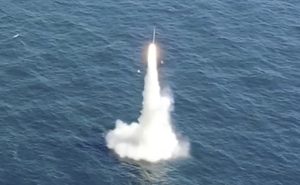The Korean Peninsula has seen an incredible number of missile tests this week, including first looks of new advanced South Korean weapons.
The most notable test may be South Korea’s successful test-launch of a submarine-launched ballistic missile (SLBM), following successful precursor tests last week.
South Korea is now only the eighth naval power with the capability of launching ballistic missiles from submarines, and the only one without nuclear weapons. Submarine-launched cruise missiles, with smaller warheads and generally shorter ranges, are a more common capability. The longer ranges and higher payload capacity of ballistic missiles make them better vehicles for nuclear weapons. South Korea says its new non-nuclear ballistic missiles are intended for use against heavily fortified targets deep in North Korean territory.
While most SLBMs have extended, even intercontinental ranges, the South Korean missile, called the Hyunmoo-4-4, likely has much shorter ranges, relevant only to the comparatively compact geography of the Korean Peninsula.
North Korea first tested its own sub-launched ballistic missile in 2016 and unveiled a new more advanced variant at a military parade in January.
South Korea’s missile was fired from its new Dosan Ahn Changho-class submarines, commissioned just last month, and observed by President Moon Jae-in, who said the new missiles would provide a “sure deterrence” against North Korean threats.
Kim Jong Un’s sister, Kim Yo Jong, a senior North Korean official in her own right, responded to South Korea’s tests and Moon’s remarks by warning that they risked the “complete destruction” of ties between the two countries. North Korea launched two ballistic missiles into the East Sea (also called the Sea of Japan) hours before South Korea’s submarine missile test on Wednesday.
Earlier in the week, North Korea tested a new type of cruise missile that reportedly traveled nearly 1,000 miles to its target and may be capable of carrying a small nuclear weapon. The missile’s range and appearance share at least superficial similarity with the United States’ 40-year-old Tomahawk cruise missiles.
South Korea also tested an advanced new land-based ballistic missile – likely a variation of the submarine-launched Hyunmoo-4-4 – as well as a new air-launched missile, and revealed advances on a new supersonic anti-ship cruise missile.
South Korea’s defense ministry said the new ballistic missiles are “capable of striking concrete buildings and underground tunnels, and it can be neutralized by striking the main target accurately and strongly. High-powered ballistic missiles with improved performance will be used as a core force to improve our military’s peacetime deterrence capabilities and project overwhelming response capabilities in case of emergency.”
The defense ministry released videos of the various missile tests, as well as tests of an advanced new solid-propellant rocket motor.
South Korea’s tests follow the official lifting of four-decade old-restrictions on South Korea’s missile development at a summit between U.S. President Joe Biden and Moon at the White House in May. To prevent unwanted escalation on the Korean Peninsula and placate potential concerns of other Northeast Asian countries, the United States had imposed limits on the range and warhead-size of South Korea’s arsenal of ballistic missiles as a condition of the two countries’ alliance. As North Korea became a nuclear power and has improved its conventional arsenal of missiles as well, those limitations were repeatedly relaxed, and now South Korea faces no restrictions from the United States on its ballistic missile development.

































